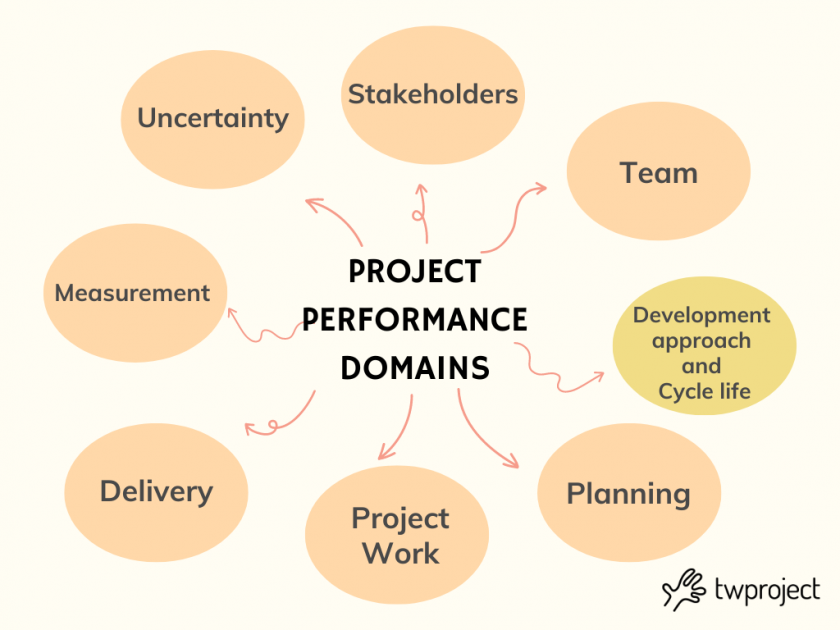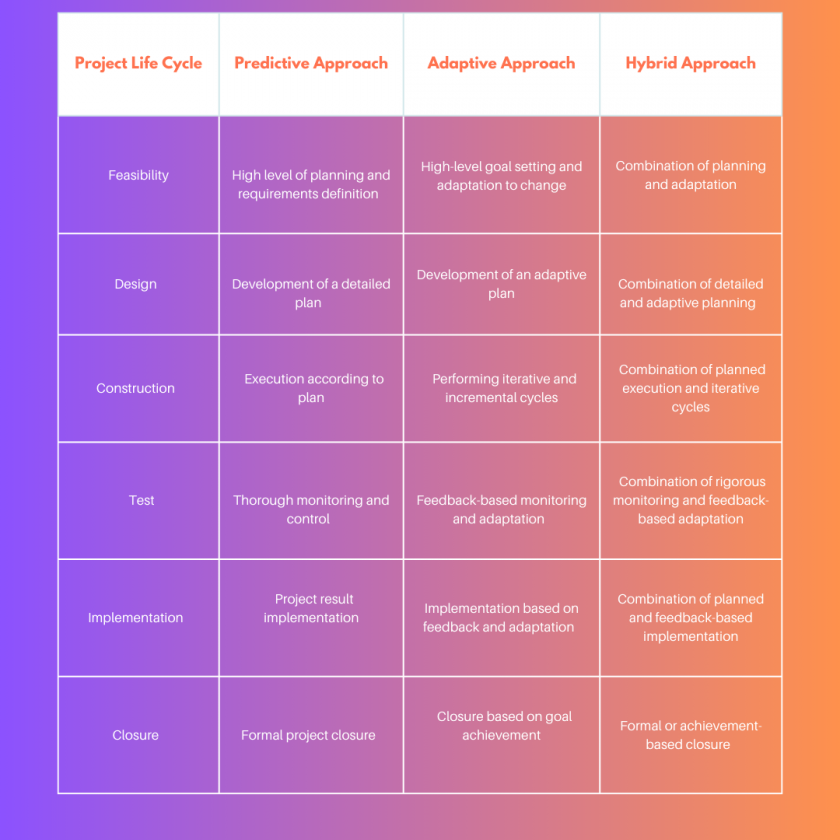|
Getting your Trinity Audio player ready...
|
The life cycle and development approach are strategic in the Performance Domain.
As detailed in PMBOK 7, the goal is to establish the appropriate pace at which to carry out a project’s activities to generate value.
It is based on a key concept: each project is unique – no single development approach can be applicable to every planning.
CONTENT
- What do we mean by development approach and life cycle performance domain?
- Development approach and life cycle performance domain: the components
- Deliverable & project deliverables
- Development approaches: the most common for PMBok 7s
- Stages of the project life cycle: a few examples
- Development Approach and Project Life Cycle: potential interactions
- Development Approach & Life Cycle Performance Domain: interactions with other domains
In this article, we chose to delve into this topic and fully understand its development in our business projects.
What do we mean by development approach and life cycle performance domain?

The Development Approach & Life Cycle Performance Domain, detailed in the latest edition of the PMBOK, refers to managing all phases of a project’s life cycle from start to finish.
Thanks to this approach, the value of a project can be fully maximized by including:
- goal setting;
- activity planning;
- resource management;
- progress monitoring.
Making sure the project meets quality, time, and cost standards-this is the ultimate goal of this Performance Domain.
Development approach and life cycle performance domain: the components
For this domain to be effectively executed strategically and to yield concrete results, it is crucial to cross three key components:
- Project deliverables and their delivery frequency.
- Project development choice with relevant approaches
- Product life cycle definition.
Starting with the project deliverable and delivery schedule, you determine the approach and steps to follow.
Deliverable & project deliverables
Deliverables depend on the project’s nature, end-user preferences, and scope requirements.
These are divided into:
- Single delivery: The product or service distribution on a single instance, usually at the end of the project. A typical example is the sale of a product to the end customer.
- Multiple deliveries: a project might feature various components that will be delivered at different points in time, not necessarily in regular periods – typical in software projects.
- Periodic deliveries: these are similar to multiple deliveries but follow a fixed and regular delivery schedule. For example, a newspaper that is published weekly or a monthly newsletter.
Development approaches: the most common for PMBok 7
Approaches to project development can differ based on the nature of the project, its needs, and challenges.
Here are some of the most common approaches, also outlined by PMBok 7 as being among the most popular:
1. Predictive approach: this approach, also known as the waterfall approach, involves detailed planning at the beginning of the project. It is used when scope, costs, resources, and risks can be clearly defined at the earliest stages of a project. In this case, the uncertainty level is minimal since the life cycle is stable. Therefore, planning also remains approximately the same throughout the project’s lifespan.
2. Adaptive approach: this approach is flexible and allows for adaptation to project life cycle changes. It is used when project requirements are subject to high uncertainty and volatility. Feedback from users and stakeholders is collected repeatedly over the project life cycle to adapt and fine-tune the development strategy.
3. Hybrid approach: this approach combines some of the predictive and adaptive elements discussed earlier. This approach is used where levels of uncertainty around design requirements are manifest. The combination of both developments-iterative or incremental-is great where different options need to be studied and evaluated.
Table: Types of Development Approaches and Primary Plus
| Approach | Description |
| Predictive | Detailed planning at the beginning of the project |
| Adaptive | Flexibility and adaptation to change |
| Hybrid | Combination of predictive and adaptive elements |
Stages of the project life cycle: a few examples
The project life cycle describes the stages a project goes from inception to completion. The type and number of project phases depend on several variables, including the pace of delivery and the approach to development.
Here are some examples of phases in a project life cycle:
- Feasibility: This stage determines whether the business case is sound and whether the organization can deliver the expected outcome.
- Design: planning and analysis lead to the creation of the project outcome that will be developed.
- Construction: outcome building is carried out with integrated quality assurance activities.
- Test: final quality review and result check are carried out before transition, activation, or customer acceptance.
- Implementation: project results are brought into use, and transition activities necessary for sustainability, benefit realization, and organizational change management are completed.
- Closure: the project is closed, knowledge and artifacts are archived, project team members are discharged, and contracts are terminated.
The performance domain in PMBOK7 and the development and project life cycle approach are key concepts in project management.
Choosing the right approach can have a significant impact on project success. For this purpose, we have compiled a table to analyze how different approaches behave concerning the stages of the project life cycle.
We needed a tool that could support both predictive and iterative projects, enabling each team to choose the most appropriate approach. Twproject supports both out-of-the-box.

Development Approach and Project Life Cycle: potential interactions
Which approach should be chosen for development? The potential interactions are different.
Considering the strong correlation between the project life cycle and approaches, we thought we would create a table that could highlight how the execution of different approaches changes according to the stages of the project life cycle.
Comparison Table of Development Approaches and Project Life Cycle

Development Approach & Life Cycle Performance Domain: interactions with other domains
All Performance Domains described in PmBOK 7 are interconnected intrinsically with each other.
Planning is strongly influenced by the type of approach chosen and the resultant project life cycle.
This domain plays a part in setting clear objectives, planning activities, and integrating the different phases of the project.
It also involves constant monitoring of performance and any necessary corrections or adjustments.
Release of deliverables, planning, teams, stakeholders, measurements, and uncertainties are all part of the development approach and lifecycle performance domain.
The approach will be adjusted differently depending on what happens in each domain, and vice-versa.
The Development Approach & Life Cycle Performance Domain is key to project success.
This domain also helps to fully maximize the value of the project and achieve its goals by:
- thoughtful planning,
- effective resource management,
- performance monitoring
- and active involvement of stakeholders.
Furthermore, it promotes an integrated and consistent approach to project management, providing a better understanding of desired performance and allowing for rapid problem identification and resolution.
However, it should be made clear that this approach requires the project manager to have a mix of technical, management, and interpersonal skills. Implementation is more complex, but it is worth it to achieve successful results.
Who can give you the right support in this activity?
Twproject is the tool that helps you define and plan activities within your project, adapting and suggesting the approach to follow.
With this tool you will always have a complete view of your project, you will be able to plan in advance and follow the progress of every aspect of it as it unfolds, identifying critical paths and avoiding bottlenecks.
In fact, Twproject sends you notifications in case of delays, overloads, overdue tasks, overbooked teams, and other information at every project level.
Companies that rely on Twproject are able to plan projects in an excellent and transparent way, improving team efficiency and maximising overall productivity.
Take a 15-day free trial and keep track of every phase of your project lifecycle!




